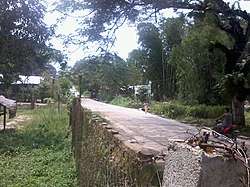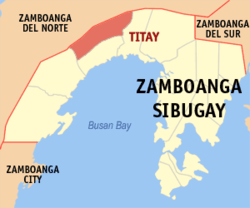Titay, Zamboanga Sibugay
| Titay | |
|---|---|
| Municipality | |
| Municipality of Titay | |
 | |
 Map of Zamboanga Sibugay with Titay highlighted | |
.svg.png) Titay Location within the Philippines | |
| Coordinates: 7°51′N 122°33′E / 7.85°N 122.55°ECoordinates: 7°51′N 122°33′E / 7.85°N 122.55°E | |
| Country |
|
| Region | Zamboanga Peninsula (Region IX) |
| Province | Zamboanga Sibugay |
| District | 2nd District |
| Founded | May 24, 1959 |
| Barangays | 29 (see Barangays) |
| Government [1] | |
| • Type | Sangguniang Bayan |
| • Mayor | Mec D. Rillera |
| • Electorate | 30,281 voters (2016) |
| Area [2] | |
| • Total | 350.44 km2 (135.31 sq mi) |
| Population (2015 census)[3] | |
| • Total | 49,673 |
| • Density | 140/km2 (370/sq mi) |
| Time zone | UTC+8 (PST) |
| ZIP code | 7003 |
| PSGC | 098315000 |
| IDD : area code | +63 (0)62 |
| Climate type | Tropical climate |
| Income class | 2nd municipal income class |
| Revenue (₱) | 137,819,659.55 (2016) |
| Native languages |
Subanon language Cebuano Chavacano Tagalog |
| Website |
titaysibugay |
Titay, officially the Municipality of Titay, is a 2nd class municipality in the province of Zamboanga Sibugay, Philippines. According to the 2015 census, it has a population of 49,673 people.[3]
It was declared as a separate municipality on May 24, 1959, by virtue of Executive Order No. 395.[4]
Barangays
Titay is politically subdivided into 30 barangays.
- Achasol
- Azusano
- Bangco
- Camanga
- Culasian
- Dalangin
- Dalangin Muslim
- Dalisay
- Gomotoc
- Imelda (Upper Camanga)
- Kipit
- Kitabog
- La Libertad
- Longilog
- Mabini
- Malagandis
- Mate
- Moalboal
- Namnama
- New Canaan
- Palomoc
- Poblacion (Titay)
- Poblacion Muslim
- Pulidan
- San Antonio
- San Isidro
- Santa Fe
- Supit
- Tugop
- Tugop Muslim
History
In 1933 Custodio P. Mariano Sr.the first Ilocano settler, discovered a small place in the center of the poblacion and registered the name of the place in honor of his favorite cousin back in Luzon who is Cristita Mariano nicknamed "Titay" knowing that a woman's name would bring good luck to the place. The Mariano families were among the first batch of Ilocanos who came from Luzon.Followed by the Dar families who are cousins of the Marianos.
Demographics
| Population census of Titay | ||||||||||||||||||||||||||||||||||
|---|---|---|---|---|---|---|---|---|---|---|---|---|---|---|---|---|---|---|---|---|---|---|---|---|---|---|---|---|---|---|---|---|---|---|
|
| |||||||||||||||||||||||||||||||||
| Source: Philippine Statistics Authority[3][5][6][7] | ||||||||||||||||||||||||||||||||||
References
- ↑ "Municipality". Quezon City, Philippines: Department of the Interior and Local Government. Retrieved 31 May 2013.
- ↑ "Province: Zamboanga Sibugay". PSGC Interactive. Quezon City, Philippines: Philippine Statistics Authority. Retrieved 12 November 2016.
- 1 2 3 Census of Population (2015). "Region IX (Zamboanga Peninsula)". Total Population by Province, City, Municipality and Barangay. PSA. Retrieved 20 June 2016.
- ↑ "Executive Order No. 395: Creating the Municipalities of Tungawan and Titay in the Province of Zamboanga Del Sur". Official Gazette of the Republic of the Philippines. Presidential Communications Development and Strategic Planning Office. May 24, 1959. Retrieved 6 August 2014.
- ↑ Census of Population and Housing (2010). "Region IX (Zamboanga Peninsula)". Total Population by Province, City, Municipality and Barangay. NSO. Retrieved 29 June 2016.
- ↑ Censuses of Population (1903–2007). "Region IX (Zamboanga Peninsula)". Table 1. Population Enumerated in Various Censuses by Province/Highly Urbanized City: 1903 to 2007. NSO.
- ↑ "Province of Zamboanga Sibugay". Municipality Population Data. Local Water Utilities Administration Research Division. Retrieved 17 December 2016.
External links
| Wikimedia Commons has media related to Titay, Zamboanga Sibugay. |
- Official Website of the Municipality of Titay, Zamboanga Sibugay
- Philippine Standard Geographic Code
- Philippine Census Information